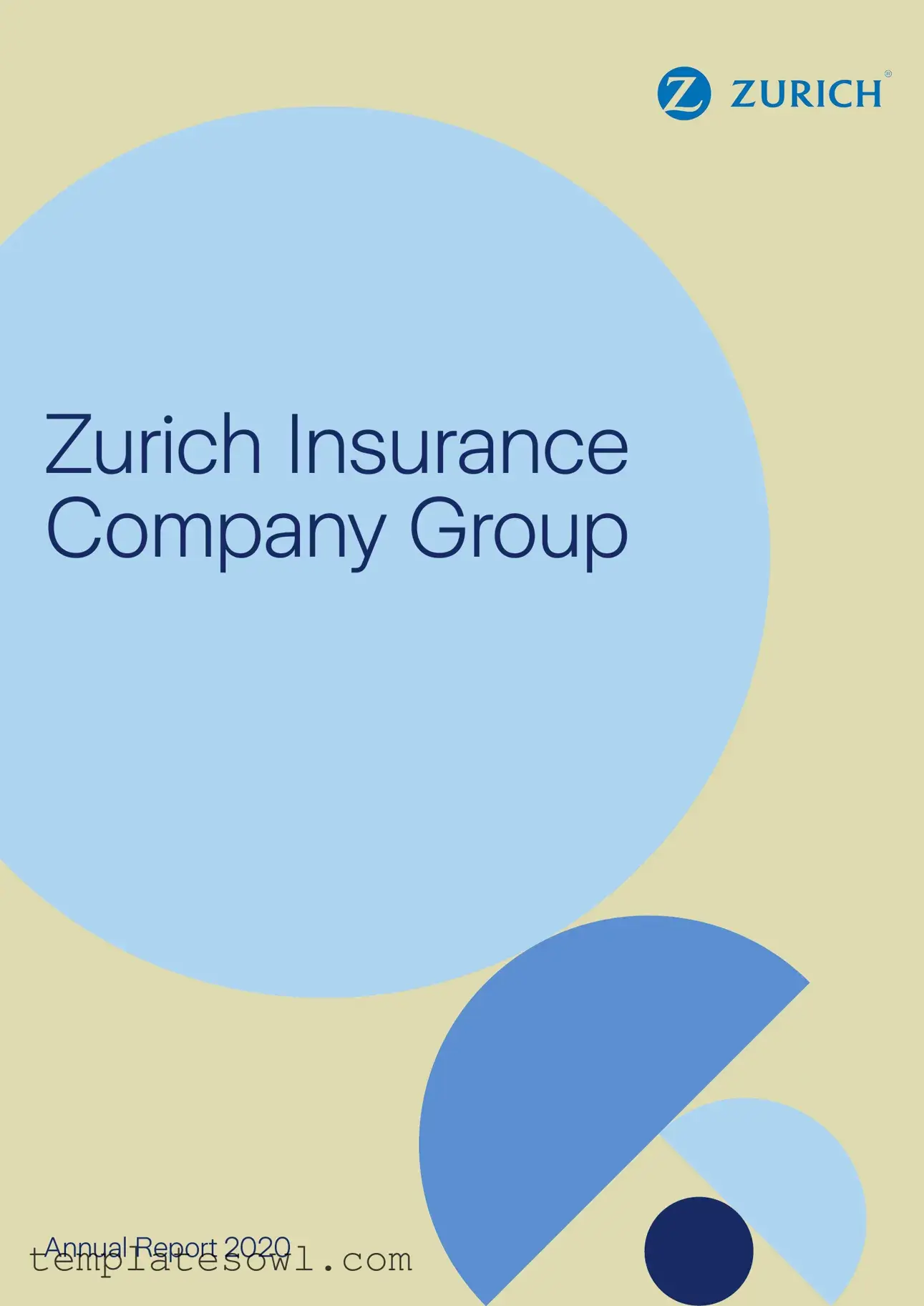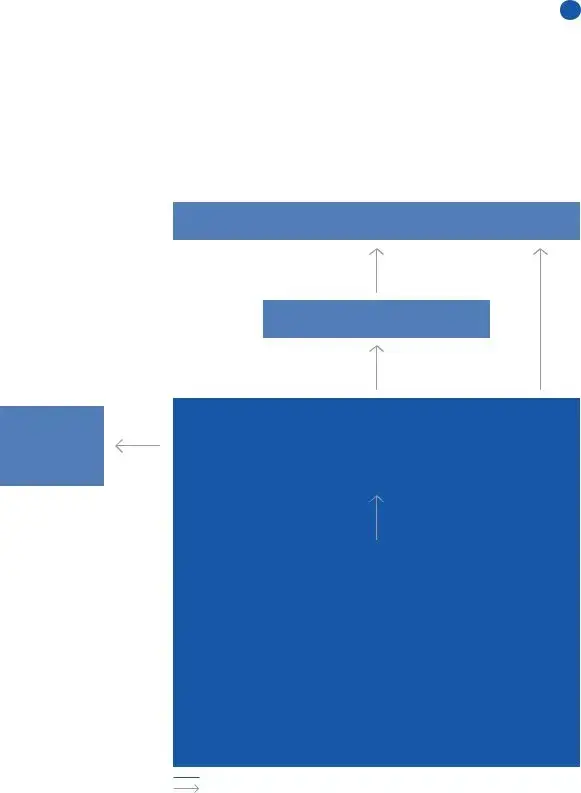Zurich Insurance Company Group
Zurich Insurance Company Group
Annual Report 2020
Contents
Risk review |
2 |
|
|
Financial review |
24 |
|
|
Financial overview |
24 |
|
|
Consolidated financial statements |
32 |
|
|
Financial statements – |
|
statutory accounts |
146 |
|
|
|
Zurich Insurance Company Group |
1 |
|
Annual Report 2020 |
|
|
|
|
|
Zurich Insurance Group (Zurich) is
a leading multi-line insurer that serves its customers in global and local markets. With about 55,000 employees, it provides a wide range of property and casualty, and life insurance products and services in more than 215 countries and territories. Zurich’s customers include individuals, small businesses, and mid-sized and large companies, as well as multinational corporations. The Group is headquartered in Zurich, Switzerland, where it was founded
in 1872. The holding company, Zurich Insurance Group Ltd (ZURN), is listed on the SIX Swiss Exchange and has a level I American Depositary Receipt (ZURVY) program, which is traded over-the-counter on OTCQX.
|
Zurich Insurance Company Group |
2 |
|
Annual Report 2020 |
|
|
|
|
|
Risk review
Contents
Risk management |
3 |
|
|
Objectives of risk management |
3 |
|
|
Risk management framework |
3 |
|
|
Risk governance and risk |
|
management organization |
5 |
|
|
Capital management |
6 |
|
|
Objectives of capital management |
6 |
|
|
Capital management framework |
6 |
|
|
Capital management program |
6 |
|
|
Insurance financial strength rating |
7 |
|
|
Regulatory capital adequacy |
7 |
|
|
Regulatory solvency regimes |
7 |
|
|
Analysis by risk type |
8 |
|
|
Insurance risk |
8 |
|
|
Market risk, including investment credit risk |
15 |
|
|
Other credit risk |
19 |
|
|
Liquidity risk |
21 |
|
|
Strategic risk and risks to the |
|
Zurich Insurance Group’s reputation |
22 |
|
|
|
Zurich Insurance Company Group |
3 |
|
Annual Report 2020 |
|
|
|
|
|
Risk review (continued)
Basis of presentation
The risk review is an integral part of the consolidated financial statements.
Risk and capital are managed at the Zurich Insurance Group, segment, region and business unit level according to the Zurich Insurance Group risk and capital management framework. The principles of the Zurich Insurance Group enterprise risk management described in the risk management and capital management sections are equally applicable to Zurich Insurance Company Ltd (ZIC) and its consolidated subsidiaries (collectively the ZIC Group).
The Zurich Insurance Group Ltd Board of Directors, Chief Executive Officer, and Chief Risk Officer equally serve as Board of Directors, Chief Executive Officer, and Chief Risk Officer for Zurich Insurance Company Ltd.
The figures presented are prepared on a ZIC Group basis.
Risk management
Objectives of risk management
Taking and managing risk is an integral part of the insurance business. Zurich Insurance Group takes and manages risks in an informed and disciplined manner and within a pre-determined risk appetite and tolerance.
The major risk management objectives at Zurich Insurance Group are to:
––Support achievement of the Zurich Insurance Group strategy and protect capital, liquidity, earnings and reputation by monitoring that risks are taken within Zurich Insurance Group’s risk tolerance
––Enhance value creation by embedding disciplined risk-taking in the company culture and contributing to an optimal risk-return profile where risk-reward trade-offs are transparent, understood, and risks are appropriately rewarded
––Efficiently and effectively diversify risk and avoid or mitigate unrewarded risks
––Encourage openness and transparency to enable effective risk management
––Support decision-making processes by providing consistent, reliable and timely risk information
––Protect Zurich Insurance Group’s reputation and brand by promoting a sound culture of risk awareness, and disciplined and informed risk-taking
Risk management framework
The risk management framework is based on a governance process that sets forth clear responsibilities for taking, managing, monitoring and reporting risks.
The Zurich Risk Policy (ZRP) is Zurich Insurance Group’s main risk governance document. It sets standards for effective risk management throughout Zurich Insurance Group. The policy describes Zurich Insurance Group’s risk management framework, provides a standardized set of risk types and defines Zurich Insurance Group’s appetite for risks at Zurich Insurance Group level. Risk-specific policy manuals provide guidelines and procedures to implement the principles in the ZRP. Ongoing assessments verify that requirements are met.
Zurich Insurance Group regularly reports on its risk profile at local and Zurich Insurance Group levels. Zurich Insurance Group has procedures to refer risk topics to senior management and the Board of Directors in a timely manner. To foster transparency about risk, the Board receives quarterly risk reports and risk updates. In 2020, additional dynamic reporting of COVID-19 risk scenarios took place.
Zurich Insurance Group identifies, assesses, manages, monitors and reports risks that have an impact on the achievement of its strategic objectives by applying its proprietary Total Risk Profiling™ methodology. The methodology allows Zurich Insurance Group to assess risks in terms of severity and probability and supports the definition and implementation of mitigating actions. At Zurich Insurance Group level, this is an annual process, followed by regular reviews and updates by management.
|
Zurich Insurance Company Group |
4 |
|
Annual Report 2020 |
|
|
|
|
|
Risk review (continued)
Zurich Insurance Group’s risk appetite and tolerance reflects Zurich Insurance Group’s willingness and capacity to take risks in pursuit of value creation and sets boundaries within which the businesses act. Zurich Insurance Group protects its capital, liquidity, earnings and reputation by monitoring that risks are taken within agreed risk appetite levels and tolerance limits. Zurich Insurance Group regularly assesses and, to the extent possible, quantifies material risks to which it is exposed.
Starting as of 2020, Zurich Insurance Group’s solvency position will be disclosed on the basis of the Swiss Solvency Test (SST) ratio to be more aligned with reporting by Zurich Insurance Group’s Swiss and European peers. The Zurich Insurance Group’s SST internal model has been fully approved by the Swiss Financial Supervisory Authority (FINMA). Zurich Insurance Group’s goal is to maintain capital consistent with a ‘AA’ financial strength rating for the Zurich Insurance Group, which translates into an SST ratio target of 160 percent or above.
Zurich Insurance Group continues to apply the Zurich Economic Capital Model (Z-ECM) as an internal metric. Z-ECM provides a key input into Zurich Insurance Group’s planning process as an assessment of Zurich Insurance Group’s economic risk profile.
Risk-based remuneration
Based on Zurich Insurance Group’s remuneration rules, the Board of Directors designs and structures remuneration arrangements that support the achievement of strategic and financial objectives and do not encourage inappropriate risk-taking. Group Risk Management’s role in respect to remuneration and its interaction with Board committees is described in the remuneration report.
|
Zurich Insurance Company Group |
5 |
|
Annual Report 2020 |
|
|
|
|
|
Risk review (continued)
Risk governance and risk management organization
Risk management organization
The Group Risk Management function is a global function, led by Zurich Insurance Group’s Chief Risk Officer (CRO).
Executive
management committees
Risk and Investment Committee of the Board
Group Chief Executive Officer
Group Chief Risk Officer
Leads the Group Risk Management function, which develops frameworks and
methodologies for identifying, assessing, measuring, managing and reporting risks throughout the Group. The Group CRO has direct access to the Board of Directors.
Group level |
|
Region and business unit level |
|
|
|
Staff at Group level focus |
|
Regional and business heads of risk |
on risk management |
|
Business unit chief risk officers |
frameworks, risk |
|
Each country has a dedicated risk management |
governance, risk reporting, |
|
|
team located with the local management team |
methodologies and tools, |
|
|
for effective business partnering activities, serving |
and qualitative and |
|
|
both management and legal entity view. |
quantitative assessments. |
|
|
|
They quantify the Group’s |
|
|
risk and economic capital |
|
|
position and monitor |
|
|
adherence to risk tolerance. |
|
|
They quantitatively assess |
|
|
insurance, market, |
|
|
credit and operational |
|
|
risk, and focus |
|
|
on model validation. |
|
|
Risk function |
The Group has committees covering oversight activities that |
Reporting about risks |
encompass major business areas. The committees review certain |
|
risk management matters for their respective areas. At the local |
|
level, these oversight activities are conducted through risk and |
|
control committees. |
The risk function is independent of the business by being a vertically integrated function where, unless otherwise required by local laws or regulations, global risk employees report directly into the Zurich Insurance Group CRO, except for Farmers’ Chief Risk Officer who has a matrix reporting line to Zurich Insurance Group’s CRO. Risk officers are embedded in the business, positioning them to support and advise on, and independently challenge, business decisions from a risk perspective. As business advisers on risk matters, the risk officers, equipped with technical risk skills as well as business skills, help foster a risk-aware culture in the business.
|
Zurich Insurance Company Group |
6 |
|
Annual Report 2020 |
|
|
|
|
|
Risk review (continued)
Capital management
Objectives of capital management
Zurich Insurance Group manages capital to maximize long-term value while maintaining financial strength within its ‘AA’ target range, and meeting regulatory, solvency and rating agency requirements.
As of December 31, 2020, the International Financial Reporting Standards (IFRS) for Zurich Insurance Company Group (ZIC Group) shareholders’ equity amounted to USD 37.5 billion and subordinated debt of USD 8.3 billion.
ZIC Group strives to simplify its legal entity structure to reduce complexity and increase fungibility of capital.
Capital management framework
Zurich Insurance Group’s capital management framework forms the basis for actively managing capital within Zurich Insurance Group. Zurich Insurance Group uses a number of different capital models, taking into account economic, regulatory, and rating agency constraints. Zurich Insurance Group’s capital and solvency position is monitored and regularly reported to the Executive Committee (ExCo) and Board of Directors.
Zurich Insurance Group’s policy is to allocate capital to businesses earning the highest risk-adjusted returns, and to pool risks and capital as much as possible to operationalize its risk diversification.
Zurich Insurance Group’s executive management determines the capital management strategy and sets the principles, standards and policies to execute the strategy. Group Treasury and Capital Management executes the strategy.
Capital management program
Zurich Insurance Group’s capital management program comprises various actions to optimize shareholders’ total return and to meet capital needs, while enabling Zurich Insurance Group to take advantage of growth opportunities. Such actions include paying and receiving dividends, capital repayments, share buy-backs, issuance of shares, issuance of senior and hybrid debt, securitization and purchase of reinsurance.
Zurich Insurance Group seeks to maintain a balance between higher returns for shareholders on equity held and the security that a sound capital position provides, also for our customers. Dividends, share buy-backs, and issuances and redemption of debt have a significant influence on capital levels. In 2020, Zurich Insurance Group paid a dividend out of retained earnings, issued shares out of contingent capital to fund vesting of shares in 2020, bought own shares to reduce future dilution from share-based employee plans and issued senior and hybrid debt to finance redemptions and investments in Zurich Insurance Group’s development.
The Swiss Code of Obligations stipulates that dividends may only be paid out of freely distributable reserves or retained earnings. Apart from what is specified by the Swiss Code of Obligations, Zurich Insurance Company Ltd (ZIC) faces no legal restrictions on dividends it may pay to its shareholders. As of December 31, 2020, the amount of the statutory general legal reserve was more than 40 times the paid-in share capital. The ability of Zurich Insurance Group’s subsidiaries to pay dividends may be restricted or indirectly influenced by minimum capital and solvency requirements imposed by insurance and other regulators in the countries in which the subsidiaries operate. Other limitations or considerations include foreign exchange control restrictions in some countries, and rating agencies’ methodologies.
For details on issuances and redemptions of debt, see note 18 of the ZIC Group consolidated financial statements.

|
Zurich Insurance Company Group |
7 |
|
Annual Report 2020 |
|
|
|
|
|
Risk review (continued)
Insurance financial strength rating
Zurich Insurance Group has interactive relationships with three global rating agencies: S&P Global Ratings, Moody’s, and AM Best. The insurance financial strength rating (IFSR) of Zurich Insurance Group’s main operating entity, Zurich Insurance Company Ltd, is an important element of Zurich Insurance Group’s competitive position, while Zurich Insurance Group’s credit ratings also affect the cost of debt capital.
The insurance financial strength ratings remained unchanged in 2020 despite the impact of COVID-19 on earnings, balance sheet and capital. The three rating agencies affirmed Zurich Insurance Group’s IFSR, with S&P maintaining its “positive” outlook on the rating, based on their view of Zurich Insurance Group’s solid solvency position, strong competitive position, diversified sources of earnings and limited net underwriting losses related to COVID-19.
The planned acquisition by Zurich Insurance Group’s subsidiary Farmers Group, Inc (FGI) and Farmers Exchanges of the U.S. Property & Casualty division of MetLife and its financing was seen as a credit positive for Zurich Insurance Group by Moody’s and further supported Zurich Insurance Group’s positive outlook by S&P. The agencies consider that the acquisition will increase the contribution of Farmers Management fees to the profits, while Zurich Insurance Group maintains a strong capitalization and high financial flexibility.
As of December 31, 2020, the IFSR of Zurich Insurance Company Ltd, the main operating entity of Zurich Insurance Group, was ‘AA–/Positive’ by S&P Global Ratings, ‘Aa3/Stable’ by Moody’s, and ‘A+ (Superior)/Stable’ by AM Best.
Regulatory capital adequacy
Zurich Insurance Group endeavors to manage its capital so that its regulated entities meet local regulatory capital requirements. In each country in which Zurich Insurance Group operates, the local regulator specifies the minimum amount and type of capital that each of the regulated entities must hold in addition to their liabilities. In addition to the minimum capital required to comply with the solvency requirements, Zurich Insurance Group aims to hold an adequate buffer under local solvency requirements to ensure regulated subsidiaries can absorb a level of volatility and meet local capital requirements.
Regulatory solvency regimes
Regulatory requirements in Switzerland
The Swiss Solvency Test (SST) adopts a risk-based and total balance sheet approach. Insurance companies that are part of the ZIC Group in Switzerland are required to provide a market-consistent assessment of the value of their assets and liabilities. Possible changes to these balance sheet positions are modelled over a one-year period to arrive at the total required capital.
Under SST, insurance companies and insurance groups can apply to use company-specific internal models to calculate risk-bearing and target capital, as well as the SST ratio. The SST ratio must be calculated as per January 1 and submitted to the Swiss Financial Market Supervisory Authority (FINMA).
Regulatory requirements in the European Economic Area (EEA)
The main regulatory framework governing Zurich Insurance Group’s subsidiaries in the EEA is Solvency II. This is
a risk-based capital framework which covers capital requirements (pillar 1), governance and risk management (pillar 2) and reporting (pillar 3). All EEA-based legal entities of Zurich Insurance Group use the Solvency II standard formula for their pillar 1 requirements with the exception of Zurich Insurance plc (Ireland) that applies an approved internal model.
Regulatory requirements in the UK
The United Kingdom left the EU and the EEA on January 31, 2020 and the transition period ended on December 31, 2020, meaning that UK regulations can diverge from Solvency II regulatory requirements.
Regulatory requirements in the U.S.
In the U.S., required capital is determined to be ‘company action level risk-based capital’ calculated using the National Association of Insurance Commissioners’ risk-based capital model. This method, which builds on statutory accounts, measures the minimum amount of the capital for an insurance company to support its overall business operations by taking into account its size and risk profile.
Regulatory requirements in other jurisdictions
Every country has a capital standard for insurance companies. Several jurisdictions (e.g., Brazil and Mexico) have implemented approaches similar to Solvency II.
|
Zurich Insurance Company Group |
8 |
|
Annual Report 2020 |
|
|
|
|
|
Risk review (continued)
Analysis by risk type
Insurance risk
Insurance risk is the inherent uncertainty regarding the occurrence, amount or timing of insurance cash flows. The profitability of insurance business is also susceptible to business risk in the form of unexpected changes in expenses, policyholders’ behavior, and fluctuations in new business volumes. Zurich Insurance Group manages insurance risk through:
––Specific underwriting and claims standards and controls
––Robust reserving processes
––External reinsurance
Property and casualty insurance risk
Property and casualty insurance risk arises from coverage provided for motor, property, liability, special lines and worker injury. It comprises premium and reserve risk, catastrophe risk, and business risk. Premium and reserve risk covers uncertainties in the frequency of the occurrence of the insured events as well as in the severity of the resulting claims. Catastrophe risk predominantly relates to uncertainty around natural catastrophes. Business risk for property and casualty predominantly relates to unexpected increases in the expenses relating to claims handling, underwriting, and administration.
Management of Property & Casualty business insurance risk
Zurich Insurance Group’s underwriting strategy takes advantage of the diversification of Property & Casualty (P&C) risks across lines of business, customers and geographic regions. Zurich Insurance Group defines Group-wide governance for insurance risk including for new products. Underwriting discipline is a fundamental part of managing insurance risk. Zurich Insurance Group sets limits on underwriting capacity and delegates authority to individuals based on their specific expertise and sets appropriate underwriting and pricing guidelines. Technical reviews assure that underwriters perform within authorities and adhere to underwriting policies.
Property & Casualty insurance reserves are regularly estimated, reviewed and monitored by qualified and experienced actuaries at local, regional and Zurich Insurance Group levels. To arrive at their reserve estimates, the actuaries take into consideration, among other things, the latest available facts, trends and patterns of loss payments. Inflation is monitored with insights feeding into actuarial reserving models and Zurich Insurance Group’s underwriting processes and pricing.
To ensure a common understanding of business insights and new trends for reserve analysis, financial plans, underwriting and pricing decisions, Zurich Insurance Group has established a culture of continuous cross-functional collaboration. For this, underwriting, actuarial (pricing and reserving), claims, finance, sales and distribution, risk engineering and risk management contribute to quarterly meetings at local and Zurich Insurance Group level.
Zurich Insurance Group’s Emerging Risk Committee, with cross-functional expertise from core insurance functions such as underwriting, claims and risk management, identifies, assesses and recommends actions for emerging risks.
Governance is in place to ensure appropriate focus on top-line targets and profitability. Reinsurance is deployed to help manage insurance risk. Group Risk Management also provides independent assurance through risk reviews.
Zurich Insurance Group is exposed to losses that could arise from natural and man-made catastrophes. The main concentrations of risks arising from such potential catastrophes are regularly reported to executive management. The most important peril regions for natural catastrophes continue to be U.S. and Caribbean hurricane, California earthquake and Europe wind.










